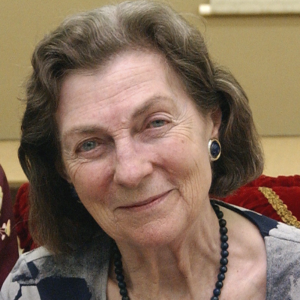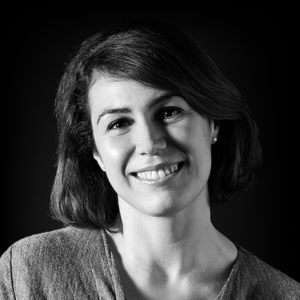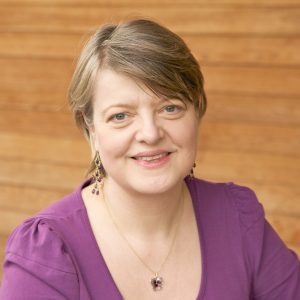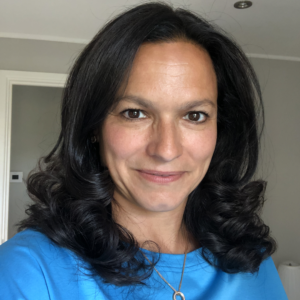 Originally published in the ebook A Passion for Science: Stories of Discovery and Invention.
Originally published in the ebook A Passion for Science: Stories of Discovery and Invention.
by Kat Arney
When I started my PhD at the Gurdon Institute in Cambridge, I was an ambitious, and probably quite insufferable, young thing straight out of university. At the other end of her scientific lifespan was Anne — more formally known as the Honourable Dame Anne Laura Dorinthea McLaren — who, even though in her 70s, was a regular and forceful presence in the lab and in our shared team meetings. Once I’d got over my arrogant assumption that this short but sprightly old lady had nothing to teach me, I became hugely respectful of her views and thoughts.
As a newly hatched scientist, I was learning my trade working with Professor Azim Surani. My research was embryonic in both senses of the word, as I tried to understand some of the earliest events that happen when life begins. Hour after hour I stared in fascination and frustration down a microscope watching perfectly spherical mouse eggs quietly split in half again and again to create tiny footballs of cells. These ghostly, transparent embryos remain the most beautiful living things I have ever seen. And in Anne, I met someone who was also utterly enchanted by the glory of life at its earliest, most fragile stages.
Anne’s curiosity about early development was the fire that fuelled a lifetime of research. And although she never boasted about it, her groundbreaking work in the 1950s laid the foundations for in-vitro fertilisation (IVF) babies, cloning and genetically engineered mice — technologies that have revolutionised human reproduction and biomedical research. Not bad for someone who had an unconventional early education and grew up during a time when science was most definitely not a ‘girl thing’. She chose to study zoology at Oxford University almost by accident. Apparently she picked the course because cramming for the biology entrance exam seemed like an easier option than doing the required reading for English literature.
Not quite like rabbits
Anne’s first taste of research came at University College London under the auspices of JBS ‘Jack’ Haldane, the renowned neo-Darwinist, science populariser and Marxist, who was also the first person to propose, as far back as 1923, a renewable hydrogen-based economy. He must have been one hell of an interesting boss, suiting Anne’s enquiring mind and political leanings, more of which later.
Following that, she headed back to Oxford for a first attempt at a PhD, vaccinating pregnant rabbits against different proteins to see if this affected the development of their fetuses. Unfortunately, the animal house in Oxford managed to dampen even the legendary ardour of rabbits, and Anne didn’t get enough pregnant animals to work with. This left her with just two years to complete a PhD, so she swapped rabbits for a much more efficiently reproducing system — viruses.
In the 1950s, polio was one of the hottest topics of medical research with plenty of research money being thrown at it, much like AIDS today. Anne switched to working with respected virologist Professor Kingsley Sanders on neurotropic viruses, which include the polio virus. However, she only published a handful of papers on viral infection (although one was quite a significant finding) as she quickly got sidetracked — both academically and personally — by Donald Michie, who had worked as a codebreaker at Bletchley Park during the war. Although he later became a major force in computing research, at this time he was pursuing his childhood hobby of mouse-breeding on a more scientific footing. As well as falling in love, Anne was developing her lifelong interest in understanding how to get “from one generation to the next”, as she described it.
She wanted to know whether babies were solely a product of the combined genes of their parents (and, by implication, all the generations that have gone before), or whether the environment both inside and outside the womb played a role too? In order to find out, she had to develop the mind-bendingly fiddly techniques that are the mainstay of mammalian embryology today. The first forays into this world of technical pain had been made by US researchers a decade before, but on a smaller and less successful scale.
Working together with Donald at UCL, Anne injected female mice from one particular genetic strain with hormones that made them ovulate a large number of eggs on cue, then set them up for romantic night with some lusty males from the same genetic background. After a couple of days, she retrieved the embryos — by this point little balls of cells floating within the mothers’ reproductive tubing — and implanted them into the wombs of mice from a different strain. Surely, she figured, if it’s all about the genes, then the baby mice should come out looking exactly like their true genetic parents. Yet this wasn’t the case, and the offspring had certain characteristics that looked more like their surrogate mother. It turns out that the womb certainly does have a view when it comes to making babies.
As part of this work, Anne perfected a number of important embryology techniques. This included finding the correct sequence of hormone injections to persuade female mice to produce an excessive number of eggs, known as super-ovulation, and the best way to transfer embryos to and from the animals’ reproductive plumbing. Today these techniques are the bedrock of transgenic mouse technology, enabling researchers everywhere to genetically engineer mice to answer all manner of scientific questions, in areas of fundamental biology, and diseases like cancer and Alzheimer’s.
Although our labs at the Gurdon Institute spent most of the time steeped in the language of reproduction, human babies (rather than mouse ones) and married life were far from my mind at such an early point in my career. In contrast, Anne married Donald in 1952 – the same year she finished her PhD – publishing several important research papers with him during the 50s. By the end of the decade she had amassed three small children and a divorce, while still keeping things going in the lab. I find this quite staggering when you consider that it was all in the days before “women’s lib” really got going.
Brave New Mice
The success of these embryo transfer experiments spurred Anne on to a more ambitious project. In the studies I’ve just described, embryos were moved straight from one mouse to another. But could such fragile forms survive and grow outside the womb? In 1958, Anne teamed up with John Biggers to carry out an experiment in mice that set the scene for the later success of IVF in humans.
Together, they took fertilised eggs from a mouse’s fallopian tubes, at the stage where they were just one or two cells, and plopped them into tiny dishes containing nutrient-rich liquid. In this artificial mockery of a womb, the cells began to grow and divide. They split once, twice, again and again, over and over, and after a few days had created the little ball of cells that scientists call a blastocyst.
That was only the first bit. Next, Anne and John had to prove that these lab-grown cellular footballs could actually develop and live. They transferred the blastocysts back into the wombs of surrogate female mice — a finicky job that requires steady hands and a lot of staring down a microscope — and were thrilled to get live mouse pups out the other end a few weeks later. It’s hard to underestimate the importance of this study, first published in Nature and now more than 50 years old, in the light of the 5 million or so bouncing human ‘test tube’ babies that have come into the world since Louise Brown was born in 1978.
At the time when she was busy making babies both inside the lab (mouse) and outside it (human), Anne quickly realised that her work would probably be applied to women at some point in the future. Even with the much more restrained media of the late 1950s Anne and John’s work hit the headlines, garnering both praise and controversy as news of these “Brave New Mice” spread. As a result, she knew it was crucial that this brave new world of reproductive technology should be communicated fairly and accurately to the public.
Some of the concern was related to confusion around the legal technicalities of sperm donation, which have since been ironed out: if a baby was created from donor sperm, the woman’s husband’s name couldn’t be put on the birth certificate. But putting the donor’s name on would make the child illegitimate — an utterly unacceptable fate at the time. This unholy hybridisation of research, reproduction and ethics led to Anne getting involved in meetings and discussions around the new technology. By the 1980s, her interest culminated in joining Baroness Mary Warnock’s eponymous Committee, which drew up the first guidelines covering the use of in vitro fertilised donated eggs and gave rise to the Human Fertilisation and Embryology Authority in 1990.
The battle of the sexes
Her interest in developmental biology well and truly stoked, Anne moved up to the Institute of Animal Genetics in Edinburgh. Now known as the Roslin Institute, it was made famous as the birthplace of Dolly the sheep, the first cloned mammal.
While establishing herself as an independent scientist Anne published many detailed and beautiful studies on mouse reproduction. These ranged from trying to figure out whether there was any rhyme or reason as to how many pups grew in each side of a mouse’s two-tubed womb (answer: err, maybe) to the effects of removing one ovary. A number of these studies were carried out with Patricia Bowman, including important work on chimaeras. Rather than being the lion/snake/goat hybrid creatures of mythology, these are created by sticking together two embryos from genetically different mouse strains when they’re each just eight cells each, and implanting them back into surrogate mothers.
Another important focus of Anne’s work through the 1960s and 70s was immunocontraception, the concept of tricking the immune system into rejecting either sperm or fertilised embryos. Although it’s unlikely that this approach will work in humans, due to the effectiveness and simplicity of the currently available methods, contraceptive vaccines are used widely today for controlling animal populations, both in the wild and in captivity.
Anne moved back to London in 1974, when she was appointed head of the Medical Research Council’s Mammalian Development Unit. Through the late 1970s and 80s, her work yet again helped to underpin a major shift forward. This time, her research helped lead to the discovery of the so-called “male” gene Sry, which tells a developing embryo to divert from the female pattern we all start out with, and take the path of maleness. For many years it was thought that a mysterious factor called the H-Y antigen, produced by male embryos, was responsible for determining their sex. But although H-Y was an attractive idea, there was little hard evidence at the time to support its actual existence.
In 1984, Anne and Liz Simpson published a paper in Nature, describing “indisputably male” mice that lacked H-Y. These little squeakers blew the idea that H-Y was the elusive maleness factor completely out of the water. She also worked with Marilyn Monk on “sex-reversed” mice, which are genetically female (carrying two X chromosomes) but appear, to all intents and purposes, to be male. After a couple more years of detailed genetic detective work, Anne and Liz tracked down the location of H-Y on the Y chromosome. Meanwhile, Peter Goodfellow and Robin Lovell-Badge claimed the big game, hunting down the true determinant of maleness, the Sry gene, in 1990.
Perhaps one of the more overlooked aspects of Anne’s work, and something researchers today would do well to rediscover, was some of the research she carried out with Donald back in their early days in the 1950s, looking at how different genetic strains of mice respond to the barbiturate drug Nembutal. While it’s an amusing mental picture to wonder what a mouse on drugs looks like, Anne had a more serious purpose in mind. They discovered that highly inbred, ‘pedigree’ mice had a much more variable response to Nembutal than animals that were bred by crossing two pure-bred strains, or those with an even more mixed heritage.
As Anne and Donald took pains to point out at the time, this variability had big implications for the growing number of researchers using mice to test various drugs and other compounds. Inbred mice are easy and cheap to produce — you just stick a male mouse in a cage together with a bunch of females from the same strain and let nature take its course — while producing more complex genetic mixtures takes time and effort. But these contrary results showed that the assumption of uniformity, at least on a genetic level, isn’t always best if you want to get reliable results. Their findings still resonate today, as answers to the question of how our genes influence the way we respond to the world around us are still waiting to be be found.
In her later work Anne became obsessed with what she used to call “the most fascinating and deeply mysterious cells of all” — the germ cells that will become eggs and sperm in an adult. The cells that will form the germline and be used to create the next generation are chosen just a few days after fertilisation, and must be protected from any kind of damage or interference from the developmental tumult around them. Once formed, these precious time-capsules begin to crawl through the embryo, migrating into the tiny blobs that will eventually become ovaries or testicles.
At the time she got interested in germ cells, there was no way of identifying them with any kind of molecular ‘label’. In fact, there was very little known about them at all. Anne developed a technique for staining germ cells with a red dye, a significant step forward in tracking down their elusive location within the developing embryo. She then devoted the rest of her research career to pinning down the characteristics of these unique cells, trying to understand where they came from, where they were going, and what made them so special.
Not just research
Anne’s record outside the lab is almost as prolific as her scientific output. She was the first woman to serve as an officer of the prestigious (not to mention male-dominated) Royal Society in its 300-plus years of history, taking on the job of foreign secretary from 1991 to 1996. This role in particular revealed one of her more unusual talents — the ability to evade jetlag. Travelling economy class everywhere with just a small rucksack and a plastic bag of scientific papers, Anne would happily trundle off a transatlantic flight straight into an academic conference, and be first into the bar afterwards. She wasn’t totally superhuman though, and apparently described herself as “not very good with people in the morning”.
As well as the Royal Society and the Warnock Committee, Anne was involved in a number of other public committees and organisations, both in the UK and on an international level. Many of these were focused on challenging ethical issues surrounding reproductive technology. She frequently wrote thoughtful and rigorously evidenced articles on these topics, including IVF and prenatal diagnosis (testing embryos and babies for genetic diseases while still in the womb), as well as cloning and stem cell research. Later in life she developed an interest in conservation, and helped to set up the Frozen Ark project in 1996, aiming to freeze cells from a huge range of species before extinction claims them. The hope is that in due course, cloning technology will have developed to the extent that extinct species can be resurrected from these tiny frozen nuggets of life.
Another thing that often comes up when people talk about Anne are her political beliefs. She was born into a wealthy, aristocratic family — her dad was Lord Aberconway, the Liberal MP — but they were far from being ‘toffs’. Much of the family’s money came from industry, and they were known for their liberal politics and support of the suffragist movement. Scientists are generally a left-leaning bunch, but it’s probably fair to say that Anne was a raging lefty, even by these standards. She was a member of the communist party in her early days, which made visiting the US for conferences a bit tricky, and had a strong sense of social responsibility and social justice. It’s clear from all her interactions that she wanted to make the world a better, fairer place.
As a working single mother, Anne was very keen on pushing for better childcare for the offspring of young researchers, whether working in the lab or at conferences. She firmly believed that a lack of affordable, convenient and reliable childcare was a key factor in making it difficult for women to reach the top in science. I remember staff at the Gurdon Institute repeatedly begging management for some kind of creche facility and, more than a decade later, they still don’t have one. There was also much grimacing when the university sent round a survey to all the female researchers, asking us what one thing would help us in our careers. At least one embittered post-doc ironically wrote “a wife” on the dotted line. But Anne also lived by her principles in the way she ran her lab and would often berate the researchers with young families, telling them them go home and spend time with their kids. That went for the men as well as the women.
Thanks to her prolific research career and numerous extracurricular commitments, Anne had little time for interests outside the scientific world. The exception seems to have been her own children, and later grandchildren. It’s unknown whether she had any other partners after her divorce, but it’s hard to see how she would have found the time. Donald remarried, but they remained on good terms and reconnected later in life, living as a couple again after his second wife died.
On to the next generation
When I worked with Anne at the Gurdon Institute she was already in her 70s, yet had more energy and enthusiasm for research than many of us PhD students. While on paper she should have retired in 1992, it was impossible to imagine how her scientific light might be dimmed.
When my PhD supervisor Azim describes the last time he saw her on Friday 6th July 2007, his usual gentle tone is tinged with the sadness he still palpably feels at the loss of a close and insightful colleague. He and Anne were discussing a newly-published paper that appeared to have some interesting implications for their overlapping interest in stem cells. Anne promised to chat about it over coffee with him on Monday. Their meeting never happened.
That Sunday, Anne and Donald died together in a car accident on the M11 motorway while driving back to their home in the capital after a colleague’s wedding. The academic spheres of biology and computing reverberated with the devastating news. Both of them were still active in research, despite being in their 80s, and were much loved by colleagues, family and friends. While most of the media coverage rightfully mourned the loss of two great and still-vigorous minds, nil points go to The Daily Mail for their rather one-sided headline, “Wartime codebreaker dies in motorway crash”.
Anne left behind a tremendous legacy. Part of it is hard-coded in the hundreds of research papers and articles she wrote, including two highly-respected books that helped to define her field: Mammalian Chimaeras and Germ Cells and Soma. There’s also the numerous awards including the Royal Society’s Royal Medal, the prestigious Japan Prize for Developmental Biology, and her Damehood. But just as important is the softer stuff — the influence she had on others, and the scientific lives she helped to shape. Anne headed the Mammalian Development Unit in London for many years, and a significant proportion of the UK’s developmental biologists passed under her command at some point. She had a fiendishly sharp mind and a reputation for being very direct; she detested what she called “sloppy thinking”. This could seem terrifying to the uninitiated, but she was very warm when you got to know her (and she did mellow out a bit as she got older).
For many years, Anne also taught on the Cold Spring Harbour experimental embryology of the mouse course, helping cack-handed learners get to grips with the finer points of the animals’ internal organs. Having benefited from her patient teaching myself, I can only hope that these students appreciated the opportunity they had to learn from someone who had complete mastery of her craft. When it came to embryo work, Anne preferred to use her old 1950s dissecting microscope, now languishing under Azim’s desk in the Gurdon Institute, claiming that it had far superior optics to any modern telescope. It’s only fitting that a fund to provide fellowships for young female scientists has been set up in her memory, to enable them to kickstart an independent career.
It’s a distinguishing feature of Anne’s scientific papers that the references she cites are often drawn from many years ago. It’s rare to find someone whose research career spans five decades, and her thoughtful writing brought an incredible historical perspective that can be all-too-easily forgotten by thrusting young scientists, seduced by the latest whizzy technology. Many of the questions that intrigued Anne over the years, about the nature of inheritance and the influence of the environment on the developing fetus, still remain today and await answers.
She was always convinced that, when it comes to science, it’s the idea that’s important. Advances in technology just help each generation get closer to an answer, but they aren’t the end in themselves. Her struggles to perfect the fiddly mechanics of micromanipulation in the 50s were a means to an end: understanding the interplay between an embryo’s genes and its home. Five decades later, this is still a hot topic in research, and we’re finally getting closer to some answers. Anne was thrilled that the genetic revolution meant that she could now put ‘names to faces’ for the mysterious molecular factors at work in development. It’s a great shame that she didn’t live to see some of the more recent breakthroughs in understanding the genes and proteins that are responsible for shaping the identity of her beloved, fascinating germ cells.
Although much has been made over the years of the challenges of being a woman in science, Anne considered herself to be lucky in this respect, and never felt particularly disadvantaged by her sex. The concept of women scientists as a political entity felt strange to her. In most places she’d worked since the 1950s she felt that there were plenty of women, and they just viewed themselves as scientists. But she did concede that holding up positive female role models for up-and-coming researchers might help them to get a foothold in an increasingly competitive world.
But while Anne was exceptional, she was by no means an exception in the field of developmental biology. She’s just one of a pantheon of high-profile women who have made important breakthroughs in revealing the complex molecular ballet that turns a single fertilised egg cell into a living, breathing creature. Rosa Beddington, Mary Lyon, Marilyn Monk, Liz Robertson, Brigid Hogan and Janet Rossant are mammalian embryologists that would all be worthy of their own chapter in this book, as would those who excelled at non-mammalian systems, including Hilda Mangold and Janni Nusslein-Vollhard. I’m not sure whether it’s accident or design that brings women to study the mechanics of making babies, but there’s no doubt that these pioneers have acted as powerful role models for the next generation. Anne herself occasionally complained about the “old boy’s network”, which she felt sometimes led to men only putting forward male friends for jobs. But in a 2004 interview she did note wryly that there seemed to be an “old women’s network” developing, at least in her field, which was helping to even up the balance.
As Anne herself wrote in an eloquent review paper on genetic inheritance, “history may be circular, but the history of science is helical: it repeats itself, but each time at a deeper level”. Rather than the Newtonian idea of standing on the shoulders of giants, I like to think of scientists ourselves as forming a twisted helix through time, intertwining as we pass on skills, knowledge and friendship to those who come up behind us. Anne McLaren’s influence on the world of reproductive science and medicine corkscrews deeply back in time, and I am honoured to have been a tiny link in her chain. And her legacy will stretch for years to come in the lives of those she knew, those who knew her work, and the many, many more who benefit from it.
With grateful thanks to Professor Azim Surani for the coffee and conversation about Anne’s life and work.
About the author
Dr Kat Arney is Founder and Director of First Create The Media, and author of Rebel Cell: Cancer, Evolution and the Science of Life. She previously worked as a science communicator for the charity Cancer Research UK, after spending six years in the lab doing a PhD at the Gurdon Institute in Cambridge and a postdoc at the MRC Clinical Sciences Centre in London. She’s also a freelance science writer and broadcaster, helping to present the highly successful Naked Scientists BBC Radio show and Naked Genetics podcast, as well as documentaries for BBC Radio 4, including Fighting the Power of Pink, Whatever Happened to the Chemistry Set?, and Costing the Earth — Waste Watchers. Her work has been published in The Guardian, BBC Online, Science and other outlets, and she writes regularly for Biomedical Picture of the Day. In the rest of her spare time Kat plays in two bands, Sunday Driver and Talk In Colour, and rarely sleeps. Unsurprisingly, her blog is entitled You Do Too Much.
Web: katarney.com
Twitter: @Kat_Arney
Facebook: facebook.com/katarney
 Miriam Tocino is a software developer, programming teacher, and mum dedicated to making computers more approachable, friendly, and easy to understand. She is the author of Zerus & Ona, a book series that teaches young children about the digital world without the need for a screen.
Miriam Tocino is a software developer, programming teacher, and mum dedicated to making computers more approachable, friendly, and easy to understand. She is the author of Zerus & Ona, a book series that teaches young children about the digital world without the need for a screen. Kate Wilson is the managing director of Nosy Crow. Kate started working in publishing in 1986 and has worked in the industry ever since, mainly in children’s books. She started her career as a rights seller, and held senior management roles in publishing including MD of Macmillan Children’s Books and Group MD of Scholastic UK Ltd. She cares about good books, design, literacy and technology.
Kate Wilson is the managing director of Nosy Crow. Kate started working in publishing in 1986 and has worked in the industry ever since, mainly in children’s books. She started her career as a rights seller, and held senior management roles in publishing including MD of Macmillan Children’s Books and Group MD of Scholastic UK Ltd. She cares about good books, design, literacy and technology. Lisa Rajan writes the Tara Binns children’s books, which are about a girl who tries out different STEM-related jobs – engineer, scientist, vet, doctor, conservationist, astronaut, inventor, pilot and coder to name but a few. Tara Binns has to be creative, logical, resilient, brave and diplomatic to get the job done and save the day each time. The books aim to raise aspiration, broaden horizons and put big ideas in little minds. Lisa currently has 20 titles published by HarperCollins in their Big Cat reading scheme, with more in the pipeline. Lisa has done a fair few jobs herself since graduating with a BSc in Biochemistry and an MSc in Science Communication from Imperial College London – scientist, editor, medical writer, advertising copywriter, politician, financial researcher, book-keeper and author. She lives in London with her husband and three children and wants to be a forensic scientist and a scriptwriter when she grows up.
Lisa Rajan writes the Tara Binns children’s books, which are about a girl who tries out different STEM-related jobs – engineer, scientist, vet, doctor, conservationist, astronaut, inventor, pilot and coder to name but a few. Tara Binns has to be creative, logical, resilient, brave and diplomatic to get the job done and save the day each time. The books aim to raise aspiration, broaden horizons and put big ideas in little minds. Lisa currently has 20 titles published by HarperCollins in their Big Cat reading scheme, with more in the pipeline. Lisa has done a fair few jobs herself since graduating with a BSc in Biochemistry and an MSc in Science Communication from Imperial College London – scientist, editor, medical writer, advertising copywriter, politician, financial researcher, book-keeper and author. She lives in London with her husband and three children and wants to be a forensic scientist and a scriptwriter when she grows up.
 Originally published in the ebook
Originally published in the ebook